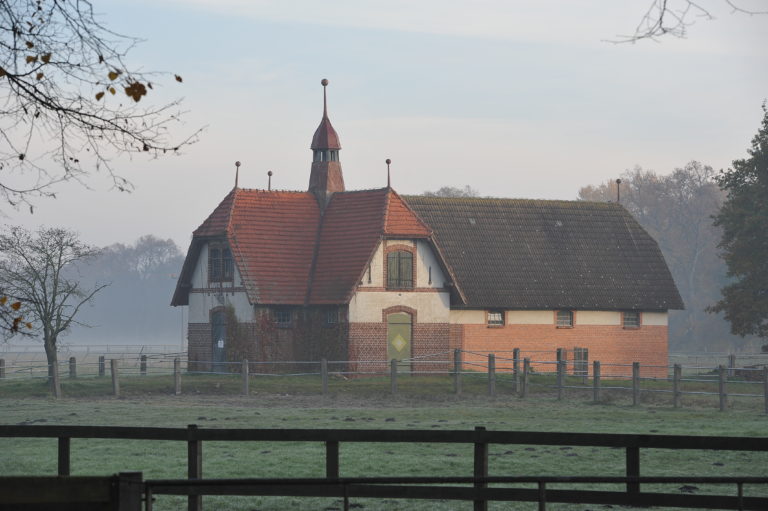Schlüter paddock
Named after the former state stable master Schlüter (1906 to 1912), this building with its striking turret was built in 1906 to offer better conditions with generous boxes and adjacent paddocks for the stud’s stallions. Today, the Schlüter paddock is generally used as a quarantine stable.


Move the slider to see the building change over time.
Dossestall stable
The Dossestall stable was quickly erected in 1961 as the thoroughbred stud at Boxberg (Thuringia) on the green border was dissolved and some of the thoroughbreds were moved to Neustadt. This state-mandated move resulted in thoroughbreds being bred at the Neustadt main stud from 1961 to 1976. Today, the Dossestall stable is used to home weaned mare foals.
Old HPA
While the stallion examination facility is now housed in the woodland castle (station 4), the young stallions used to undergo their tests in this complex of 40 horse boxes with adjacent riding hall built in 1978 by Heinz Hoppe, who was the Director of the VE stud at that time. Even today, young horses tend to be kept here as they are gently prepared for a life in sport and breeding. The success story of Neustadt’s horses has created and continues to create countless internationally renowned top horses that make their way from young horse examinations to qualifications and participation in national championships through to the big sporting stage.
The Helingstall stable
The Helingstall stable, named after the state stable master at the time, Dr Heling (1930 to 1933), is now used to keep freshly weaned stallion foals. At the age of six to eight months, the animals are weaned from their mothers and moved into a group of horses all the same age. Mother and foal separate after a certain time in the wild anyway – the mare may be pregnant again so requires her energy for the unborn foal.
The Helingstall stable was formerly known as the English shed. The first images we have are from 1843. The name refers to the English breeding period in what was the Friedrich-Wilhelm stud, where horseracing and hunting were very popular. As the English thoroughbred has particularly good racing performance and the required hardiness, the stud mostly used thoroughbred stallions and thoroughbred mares purchased from England from 1833. The English shed, or the Helingstall stable as it is known today, was used to keep these mares.
Have the entire text read aloud.

Seen and heard everything?

Our matching offers
Offers for groups and tour operators
Ideal as a stop-over destination and day trip (German website).
Carriage & Kremser rides
Experience the “Sanssouci of horses” from its most beautiful side. Away from the hustle and bustle and stress of everyday life, we offer you a special view of the Neustadt studs with a carriage or charabanc ride (German website).
Museums
The stud museum awaits visitors at the main stud and the collection of historic carriages at the state stud (German website).










